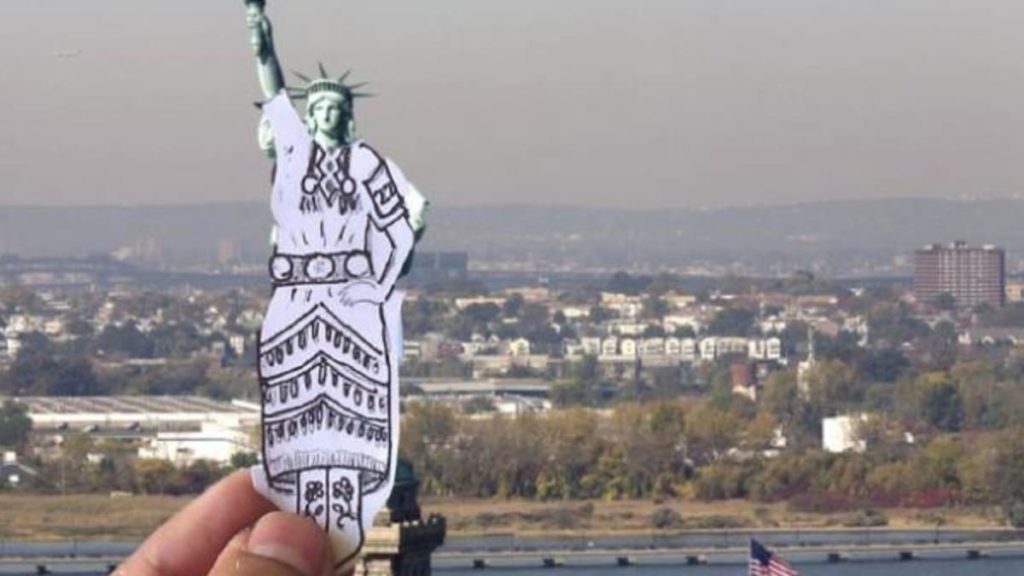The Negative Space of Tribal Sovereignty
Earlier, I wrote about how sovereignty is best understood as a network of relationships among various types of power, rather than looking at sovereignty as a measure of power. In other words, sovereignty exists when one power recognizes the powers of another, even if there are differences in the kinds and extent of those powers. This leads to more questions, and I hope to present a perspective from which anyone concerned with sovereignty can work to recognize and develop their sovereignty. I have two things going for me here that not everyone reading this has: first, I come from a people whose sovereignty has been officially recognized by treaty; and second, I have some arts training. I understand that not every Indigenous person comes from a recognized tribe, and that presents some troubling difficulties (as well as benefits). However, to be honest, I find it more lamentable that not all of us have artistic training, and will try to make a case here that an artistic perspective on sovereignty can be a big help.
Treaties, as a fact of international relations and recognition, give tribes evidence of their sovereignty. That said, treaties do not give tribes sovereignty. Treaties spell out how one sovereign power has recognized the inherent sovereignty of Indigenous peoples, but treaties do not define or limit that inherent sovereignty. Treaties contain compromises, most often in the form of a tribal nation giving up certain rights or title to lands and resources in exchange for Federal protection. US Federal law states that the inherent sovereign powers that have not been explicitly given up by tribal nations through treaties (or legal processes based on their treaties) are still held by those tribal nations. This “reserved rights” doctrine presents tribal nations with a lot of potential to develop their sovereign powers, even as treaty law has, in many cases, served to limit the vision of what tribal sovereignty could mean or could do for our peoples.
However, treaties are an incomplete picture of tribal sovereignty. When an artist draws a picture, she or he presents us with an image of a subject. It could be a portrait, or a still life, or anything put on paper. The image is placed (or posited) by the artist on paper through his or her use of ink. The paper surrounding the subject is the background; in art terms, the area around the image of the subject is called the negative space. This background can give the positive image context. For example, a portrait of a person can change meaning, depending on the setting or surroundings. The background may also provide playful and/or critical complications of the image, as in the following work by Steven Paul Judd:

(Image used with permission of Steven Paul Judd)
Some images create ambiguous images where the negative space and positive image can flip or even compete for our focus and attention. One famous example is Rubin’s vase (on the left, with an edited version on the right to clearly show the negative space):

By now you may be wondering, what does this have to do with tribal sovereignty? Well, after the quick discussion of negative space in art, I invite you to extend these art concepts as an analogy to treaty sovereignty. We need to look at treaty sovereignty in the context of treaties, but we have to recognize our power to flesh out that context outside the treaties in ways that serve our goals and values.
By analogy, treaties are the images placed on paper. They represent a relationship between sovereign entities. They are a picture of promises, agreements, definitions, and responsibilities shared between the US Federal government and tribal nations. Treaties provide a picture, or a map, of how each nation should relate to the other. They also, problematically, provide an image of each nation that we can evaluate in artistic terms—as good, as bad, as poorly composed, as balanced, as pretty, or as ugly. We can even argue over the treaties in ways that repeat these artistic evaluations, so that art historical and art criticism terms are applied in the discussions of historians, lawyers, and politicians who are all focused on the letter of the law. They are often solely focused on the subject: the treaty itself. I think that it would be good to not forget the “negative space” around the treaty, because that is where most of our inherent sovereignty remains.
Under the reserved rights doctrine, tribal nations hold on to a lot of powers. From that negative space of tribal sovereignty, some tribal nations have expanded recognition of their inherent powers, such as when tribes won jurisdiction over regulatory laws on lands covered under Public Law 280. So while State prohibitory laws apply on those reservations, tribes never gave up their rights to manage how their people enjoy legal activities such as hunting, fishing, gathering medicines, owning a gun , building a house, or driving a car.
Thus, treaty law has limited impact on how tribal nations act, and so should have only a small impact on how tribal citizens see themselves. After all, there is a lot to our lives that was never mentioned in treaties. Tribal nations can fill in the negative space of tribal sovereignty with their language , their stories, their traditional practices, their songs, and their philosophies. From that background, we can face new questions, new challenges, and create new pathways to exercise our inherent sovereignty. When faced with a choice, we can consider not just what our treaties say, but what they don’t say. If someone wants to develop on our lands, we can ask if the project is explicitly allowed by treaty. If someone wants to pressure us to accept nationalized school curricula, we can ask if the matter falls under our regulatory control as bolstered by an educational provision within our treaty. If someone wants to conduct genetic research in our community, I know of no treaty where a tribe gave up the right to control its genomic data .
Many of the victories in treaty rights began with reasserting reserved rights in terms of treaty law. As we move forward, and the issues we face become increasingly complicated, we need to assert recognition of our reserved rights on our own terms, from our own histories, and from our own perspectives. The negative space of tribal sovereignty must be filled in with our own visions of the future.
This makes self-determination our responsibility. Our sovereignty may be evident in our treaties, but treaties do not fully represent our inherent sovereignty as Indigenous peoples. It is important for us to know our stories, our teachings, our songs, and our languages. It is important for us to (re)connect with the living memories of our Elders. It is important for us to relate to the spirits of our lands. It is important to (re)connect with our ancestors so that we can provide a fuller context for our lives beyond the limits of treaty law. Rebuilding those relationships can only strengthen our struggle for self-determination.
When we look at our treaties, we need to see more than a container of our existence. We need to see the faces of everyone we are involved with, recognize how all of those relationships contribute to our existence, and work towards filling those relationships with mutual respect.